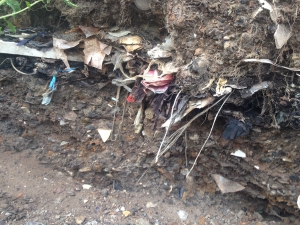Toxic timebomb from landfill site flood risk
With sea level rises and greater surface flood risk, experts have warned that thousands of old landfills could become compromised and leach a cocktail of chemicals into water courses, beaches and streets.
The UK has more than 21,000 historic landfills scattered across the country. 2,946 of these, according to analysis by the British Geological Survey (BGS), are located in flood plains. Within this group, some 1,655 contained hazardous chemicals and asbestos. However, with many dating back to 1890 and little or no formal records kept of what went in them until EU regulations were introduced in the late 1990s, there are likely to be far more.
What’s more, the vast majority were built with no coastal, riverbank or estuarine defences to protect their banks from eroding. Looking at the same set of landfills, 1,264 sites are located in coastal areas and estuaries and face the most serious risk from higher tides and storm surges.
Guy Shrubsole, Friends of the Earth Campaigner, visited Tilbury on the Thames Estuary to look at one such site. He discovered a foreshore strewn with rubbish dating back generations, showing how long much of the man-made spoil remains in situ.
The sea around the south coast has risen by approximately 10 centimetres since 1900 and this is well illustrated at Tilbury. The sandy banks had been well eroded with the remains of a former sea wall, derelict and providing no defence, could be seen below the high-water mark. The land had been stripped away to reveal layers upon layer of landfilled refuse.

Layers of exposed landfill waste exposed by higher tides on the Thames Estuary at Tilbury, Essex (Picture courtesy of Guy Shrubsole, Friends of the Earth).
No protection from old landfill sites
The Environment Agency are responsible authority for maintaining the integrity of landfill sites, but only in accordance with the tougher EU standards since they (and the Agency) were created. These regulations significantly strengthened requirements to insulate landfill waste from the surroundings and protect it from severe weather. Where there are specific issue is reported the Environment Agency will, of course, investigate and monitor leachate (contaminated fluids and wastes that issue from a landfill to soil and water) as part of their governance role.
Many other inland sites are at equal threat from river flooding and locally heavy surface rain, as well as naturally leaking into water courses, just because of a lack of barrier defences.
Dr Kate Spencer of Queen Mary University, together with a PhD student is working with the Environment Agency to produce a “vulnerability index” of the most at risk, undefended landfill sites in relation to flooding.
An offending landfill near your site?
Understanding the proximity of a landfill, its age and its interaction with water courses and flood risk is essential for landowners looking to convert sites for development.
Whether the site is on a former landfill or has had a potentially contaminative industrial past, there could be enormous nuisance and other litigation risks as a result. The site could receive toxic pollutants from a nearby source, thereby stalling development plans and creating cost and delay while the site is remediated and defended against. Or, worse still, unknown chemicals could migrate from your site to water courses affecting wildlife, habitats and nearby human population.
Either way, one of the very first considerations for landowners/developers looking to realise a land asset is to uncover the secrets of its past or that of its messy neighbours.
Our EnviroSmart range of reports assess whether a site has potential land quality issues, state who and what is at risk, and outline the solutions available.
They are the most cost effective way for you to meet local authority planning requirements and understand the risk arising from potential contamination or geotechnical hazards at the site. For more information, call us on 01743 276100 or email enquiries@geosmartinfo.co.uk.



